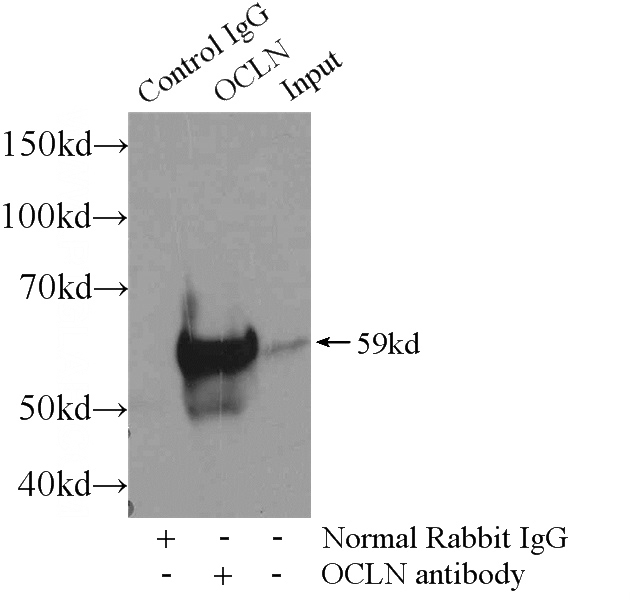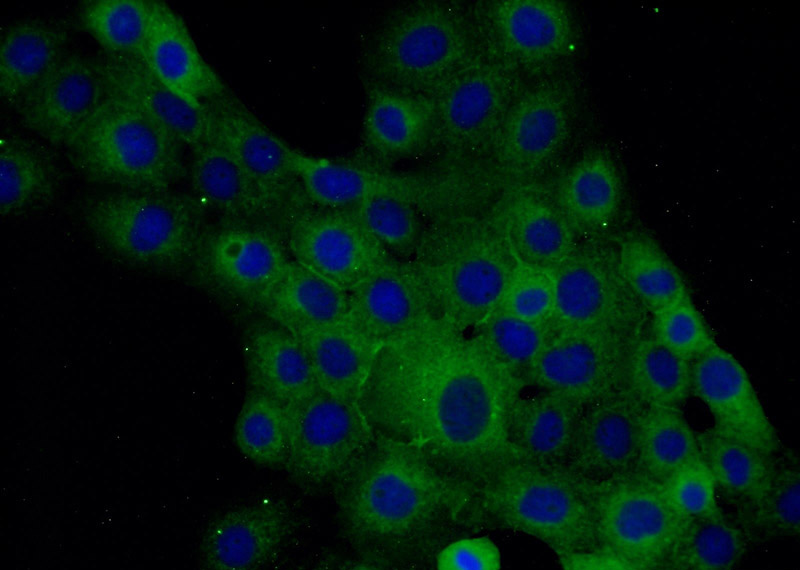-
Product Name
Occludin antibody
- Documents
-
Description
Occludin Rabbit Polyclonal antibody. Positive IF detected in A431 cells. Positive IP detected in mouse liver tissue. Positive WB detected in human liver tissue, human kidney tissue, mouse kidney tissue, mouse liver tissue, mouse skin tissue. Observed molecular weight by Western-blot: 59 kDa
-
Tested applications
ELISA, WB, IP, IF
-
Species reactivity
Human,Mouse,Rat; other species not tested.
-
Alternative names
OCcludin antibody; OCLN antibody
-
Isotype
Rabbit IgG
-
Preparation
This antibody was obtained by immunization of ℃cludin recombinant protein (Accession Number: BC029886). Purification method: Antigen affinity purified.
-
Clonality
Polyclonal
-
Formulation
PBS with 0.02% sodium azide and 50% glycerol pH 7.3.
-
Storage instructions
Store at -20℃. DO NOT ALIQUOT
-
Applications
Recommended Dilution:
WB: 1:500-1:5000
IP: 1:200-1:2000
IF: 1:10-1:100
-
Validations

human liver tissue were subjected to SDS PAGE followed by western blot with Catalog No:113466(ocLN antibody) at dilution of 1:600

IP Result of anti-occludin (IP:Catalog No:113466, 3ug; Detection:Catalog No:113466 1:500) with mouse liver tissue lysate 6400ug.

Immunofluorescent analysis of A431 cells using Catalog No:113466(occludin Antibody) at dilution of 1:25 and Alexa Fluor 488-congugated AffiniPure Goat Anti-Rabbit IgG(H+L)
-
Background
occludin is an integral membrane protein located at the tight junction. It is a tetraspanin protein with four transmembrane domains, intracellular N and C termini and two extracellular loops. occludin plays a role in the formation and regulation of the tight junction paracellular permeability barrier. occludin can exist in different isoforms, owing to modifications at the posttranscriptional and posttranslational levels (PMID: 22083955).
-
References
- Ning Q, Liu C, Hou L. Vascular endothelial growth factor receptor-1 activation promotes migration and invasion of breast cancer cells through epithelial-mesenchymal transition. PloS one. 8(6):e65217. 2013.
- Zhang X, Zhao X, Shao S. Notch1 induces epithelial-mesenchymal transition and the cancer stem cell phenotype in breast cancer cells and STAT3 plays a key role. International journal of oncology. 46(3):1141-8. 2015.
- Shao S, Zhao X, Zhang X. Notch1 signaling regulates the epithelial-mesenchymal transition and invasion of breast cancer in a Slug-dependent manner. Molecular cancer. 14:28. 2015.
- Zhang X, Miao Y, Yu X. C6orf106 enhances NSCLC cell invasion by upregulating vimentin, and downregulating E-cadherin and P120ctn. Tumour biology : the journal of the International Society for Oncodevelopmental Biology and Medicine. 36(8):5979-85. 2015.
- Li CH, Shyu MK, Jhan C. Gold Nanoparticles Increase Endothelial Paracellular Permeability by Altering Components of Endothelial Tight Junctions, and Increase Blood-Brain Barrier Permeability in Mice. Toxicological sciences : an official journal of the Society of Toxicology. 148(1):192-203. 2015.
- Ridder DA, Wenzel J, Müller K. Brain endothelial TAK1 and NEMO safeguard the neurovascular unit. The Journal of experimental medicine. 212(10):1529-49. 2015.
- Han J, Liu L, Yu N. Polysaccharides from Acanthopanax senticosus enhances intestinal integrity through inhibiting TLR4/NF-κB signaling pathways in lipopolysaccharide-challenged mice. Animal science journal = Nihon chikusan Gakkaiho. 2015.
- Wang ZG, Cheng Y, Yu XC. bFGF Protects Against Blood-Brain Barrier Damage Through Junction Protein Regulation via PI3K-Akt-Rac1 Pathway Following Traumatic Brain Injury. Molecular neurobiology. 2015.
Related Products / Services
Please note: All products are "FOR RESEARCH USE ONLY AND ARE NOT INTENDED FOR DIAGNOSTIC OR THERAPEUTIC USE"
